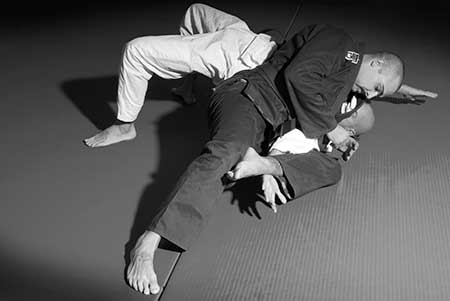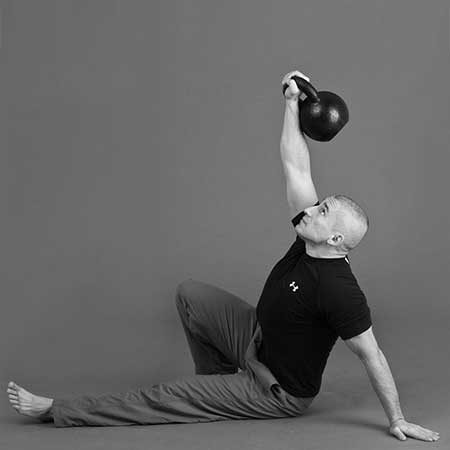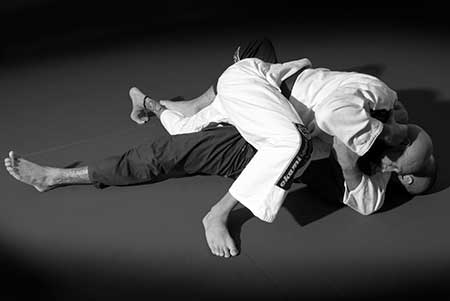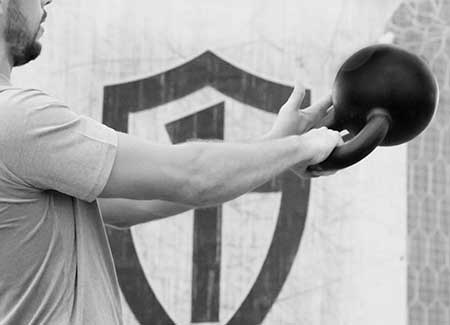“Strength fixes everything.”—Mark Reifkind
I started to work with some of the best judokas in Hungary about five years ago, and somehow it was logical I would end up training ground fighting. I joined Carlson Gracie Team Hungary (CGTH) three years ago, and today I mainly focus on Brazilian jiu jitsu, primarily in gi. For the last two years, I have worked with several CGTH black belts as a strength trainer and as a blue belt BJJ practitioner. I say I instruct strength training for BJJ, and I am not a coach of strength and conditioning, for a reason. You will figure out why soon.
If you are an SFG instructor and are dreaming about learning from the best BJJ fighters, you already have the best currency in your hand—the StrongFirst knowledge. How do I know? I used this knowledge with the best BJJ fighters in Hungary. We all became better. They became stronger, and I was able to learn directly from black belts, which is not something easy to do in the BJJ community.

How Strong Does a BJJ Practitioner Need to Be?
Well, first of all, they should be entry-level strong. What I always tell the guys is that they don’t have to be SFG-standard strong, but they have to be strong enough to dominate on the tatami, and feel confident, not only because of their skills, but because they are likely stronger than the other guy. Now, I’ve heard people say that BJJ is only technical, and there is no need to be strong. I am not arguing with black belts, but I know from experience that when skill levels are fairly similar, the extra strength somehow seems desirable.
An Important Distinction About Strength Training for BJJ
BJJ is a skill, and strength is a skill, too. The more you practice, the better you become. Period. The better you practice, the closer you get to perfection. No, I am not saying you will ever reach perfection in either BJJ or strength training, but every single day we must take one step closer.
Let me stop here for a second. If you are hoping I will give you set/reps schemes or a twelve-week program, I have some news for you. Strength training is an art and a philosophy, and just like BJJ, it can’t be squeezed in to a convenient program.
Instead, I will give you principles, because principles can do a lot more for you than a program. If you need a program, turn to any of my StrongFirst brothers or sisters for more help—they are all awesome.

The More You Practice, the Better You Become
But you can’t practice every single day, every training day with the same intensity. If you do, the price you will pay after even a short period of time is not something you will like. In my case, I train BJJ five or six times a week, and I have my own principles on how I train.
- I train with the black and brown belts one or twice a week. I don’t fight with them. That makes no sense. These trainings are helping me find my way and to see what is good and what is not so good for me.
- I also roll one or two days with purple and higher blue belts. These trainings are not easy at all. These sessions are normally four to five ten-minute rounds, and the intensity is extremely high.
- One to two days, I train with lower white belts, even training a few guys. These are my easy days, where even if we fight, I don’t use more than 50% effort.
So, just as in strength training, I have my easy, medium, and hard days, along with training that focuses more on techniques or on fighting skills. When I teach white belts, that helps me a lot, too, as I learn as much as they do through their questions.
Now, my StrongFirst friends may start to see an analogy between BJJ and strength training for BJJ. Cool. But how do you fit the actual strength training into an already tight schedule?
Rule #1
When your sport is as complex as BJJ, your strength training must be as simple as possible. In fact, your strength training should be simple anyway. No, I didn’t say easy. Simple means I don’t have to worry as a coach too much, and the training looks boring on paper, but it is challenging in real life. If my guys need more excitement, they roll. Believe me, that is crazy enough.
Rule #2
BJJ is quite demanding on the body, and keeps the practitioners in constant flexion. You make turns and rolls; you pull and you get pulled; you push and you get pushed; and you pull and push at the same time, quite often while your opponent does the same. So, against all that flexion, we must do a bunch of extension, and we neutralize the rotation with anti-rotation exercises.
Rule #3
When you train BJJ more than two times a week, you have no business with cardio, strength endurance, or any type of crazy interval program. If you have no strength, what will you endure? (Pavel.) True that. Instead of adding more risk factors to your life, let’s work on your body armor. Strength is some of the best armor, unless you can combine it with some extra muscle. But in BJJ competition, weight can be an issue. What you need is simple, effective strength training, neutralizing all the negative adaptations you might build while fighting on the tatami.

Rule #4
You can have incorporate variables when you work on your strength, but changing exercises often is the poorest choice. Again, many trainers use exercises as a tool to entertain clients. BJJ is already entertaining. You need an effective, low-risk, simple strength program, based on principles that target movements versus muscles.
Rule #5
Movements we should train to support rule number three: deadlift, one-hand floor or bench press, single leg deadlift variations, kettlebell two-hand swing, pullups, and dips.
Rule #6
Movements you should practice to maintain quality movement: goblet squat, kettlebell front squat, Turkish get-up, partial get-up, Pallof press, single-leg deadlift variations, one-hand swings, one-hand rows, and lunging presses.

Rule #7
Strength moves should be two to three exercises maximum, and normally a total of 9-12 total reps, somewhere in 75-90% of the 1RM. How many sets? Well, it takes normally 3-4 sets to accomplish the given number, with good quality movements, where all repetitions are challenging but not hard, without going to failure at all. Oh yes, the above principles are good for all the listed exercises, except heavy swings. Heavy swings are a different category. Normally I use 5×5 or 10×5 of a very heavy swing. No cardio here.
Rule #8
Practice moves should be two or three exercises, and normally total 18-25 repetitions, mainly with a 60%-80% of 1RM. Again, all reps must be good quality.
Give this program a try with your students. This program works. Guaranteed.





Amazing content!
To many reps for such heawyeights,you will build mass,and thats not the point. max strenght 3-5 reps its better
Those were total repetitions…:) Not per sets…:)
me and BJJ: Monday: Strength (clean/jerk, snatch, DL, BS/FS or OHS, alternate) Tuesday: BJJ Weds: Metcon WOD Thursday: Strength Friday: Metcon WOD Gymnastics progressions Saturday: BJJ Sunday: Rest Somedays when I’m working at home, I’ll do strength in the AM, Metcon in the PM. So far, no overtraining symptoms. Feeling great. Love jiu jitsu, by the way! Wish I could train more than twice/wk.
Great connection between two unique systems… The article itself is torough, informative, no BS. Thanks, Peter! OSSS!
*thorough
Great stuff here, Peter!
Great and timely article. I just started bjj and was considering how to supplement strength training with it. So now I know Kb training is a great compliment to it